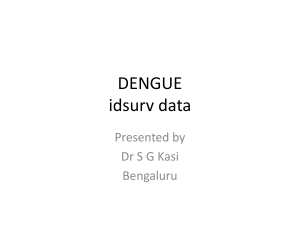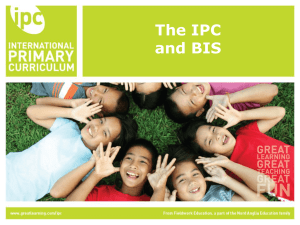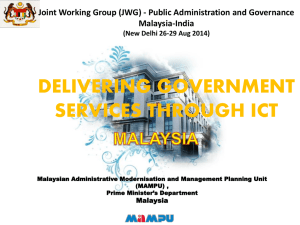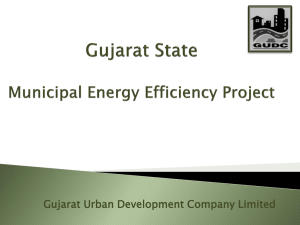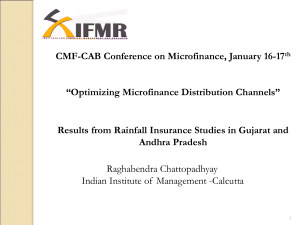Quality Enhancement Program for Higher Education
advertisement
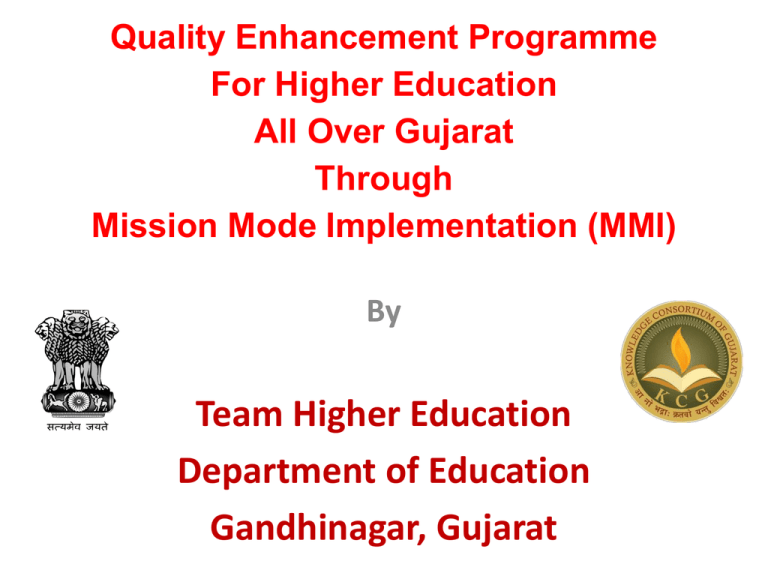
Quality Enhancement Programme For Higher Education All Over Gujarat Through Mission Mode Implementation (MMI) By Team Higher Education Department of Education Gandhinagar, Gujarat Mission Mode Implementation (MMI) Quality Enhancement Programme through Cascade Model for Higher Education State Coordinator SRG State Level State Resource Group 1 CHE + KCG + GEIC Zone Level 5 HED Level 60 Cluster Level 295 Grass Root Level 1010 Zone HED (Higher Education District) Zonal Coordinator ZRG Zonal Resource Group HED Coordinator HEDRG Higher Education District Resource Group Cluster Cluster Coordinator CRG Cluster Resource Group College Principal & Teachers + Students Mission Mode Implementation (MMI) Quality Enhancement Programme through Cascade Model for Higher Education How this Cascade Model helps in Strengthening Higher Education? • Coordination • Capacity Building : Cascade Mode of Teacher Education • Implementation of new initiatives • Monitoring • Reporting • Database • Problem Solving Mission Mode Implementation (MMI) Quality Enhancement Programme through Cascade Model for Higher Education Frequency of Meeting • College Level Meeting : Weekly • Cluster Level Meeting : Weekly • Higher Education District Level Meeting : Fortnightly • Zonal Level Meeting : Fortnightly • State Level Meeting : Monthly Face to Face / SANDHAN Initiatives for Quality Enhancement in Higher Education • CBCS : Choice Based Credit System • SAPTADHARA : Cocurricular Activities for All Round Development • SANDHAN : All Gujarat Integrated Class Room • Research & Innovation : Strengthen Research for Development • T & CB : Training & Capability Building Programme • UDISHA : Create Placement Opportunities for Students • KMPF : Knowledge Management Program for Faculty • ICT in Education : Information & Communication Technology • ALM : Active Learning Methodology • Strengthening and Revamping Libraries • VANCHE Gujarat + Gujarat Quiz • AAA : Academic and Administrative Audit + NAAC • AISHE : All India Survey of Higher Education • SCOPE • GEIC : Gujarat Educational Innovations Commission CBCS : Choice Based Credit System • A structured education system having enough room for flexibility • A system that offers choice of selection • Learner centric education with room for flexibility within a standard framework • Credit portability across the Regional/National institutes • Interdisciplinary / Vocational / Skill based Elective Courses • Project based / Activity based learning • Continuous Comprehensive Evaluation • Evaluation in terms of Grades • Interaction of Co-Curricular / Extracurricular / Extension activities within the curriculum. • Click Here for More Details SAPTADHARA • The ultimate aim of SAPTADHARA mission is to make our students enable to experience the joy of aesthetic pleasure and to learn from our great traditions of knowledge by way of taking up activities of SAPTADHARA which includes – GYAN DHARA (Activities related to Knowledge) – SARJNATMAK ABHIVYAKTI DHARA (Activities related to Creative Expression) – KALA KAUSHALYA DHARA (Activities related to fine arts) – NATYA DHARA (Activities related to drama & theatre) – GIT-SANGIT NRUTYA DHARA (Activities related to Music and Dance) – VYAYAM YOG KHEL-KUD DHARA (Activities related to Exercise, YOGA & Sports) – SAMUDAYIK SEVA DHARA (Activities related to Community/Social services). Research and Innovations • What: – To strengthen Higher Education with the help of Research and Innovations • Why: – Increasing demand for strengthening research capabilities • How: – To promote a culture of research in institutions of higher education – To provide support to teachers for strengthening their research base • Preparing research proposals • Different skills. attitude and knowledge of research • Awareness of funding sources, schemes and trends – To promote publication of journals – To provide support to institutions SANDHAN (All Gujarat Integrated Class Room) • What – All Gujarat Integrated Classroom, named as SANDHAN has been initiated in order to provide the ICT enabled quality teaching to students through the telecast of lectures and panel discussions by distinguished faculties from the State and outside. • Why – The entire world today has entered a new era of technology led quality education. – A need is seen to bring about innovation in the educational sector, breaking from the ‘chalk and talk’ method and introducing Audio-Visual aids and extending their use in imparting education becomes an obvious solution. – It is thus that ‘SANDHAN’ has been created. – It provides an extensive platform for the use of Audio-Visual tools for the telecast of lectures in an innovative and interesting manner. • How – – – – SANDHAN is a Programme with wide spread coverage. It hence entails systematic planning from conception to completion. For this, Task Force at various levels have been constituted for the purpose. There are state level coordinators who choose 10 experts for each subject. • Click Here for More Details Training and Capability Building Programme • What – Training and Capability Building of teachers, administrators and librarians so as to enable them to function as facilitators and motivators for students in a learner centric education process. • Why – With a view to enable teachers, administrators and librarians to deal with the challenges of higher education during a phase of academic and administrative reforms. • How – KCG has been organizing various Training and Capability Building Programmes – Includes Content related training and generic training on Government Initiatives – Face to face residential and non residential Training. – Satellite based Training through Sandhan – Collaboration with different training agencies, for development of training modules and delivery of the same. Click Here for More Details UDISHA • • What – Universal Development of Integrated employability Skills through Higher Education Agencies – To be a Cell focusing on bridging the gap between Job-seekers and Job-providers. Why – • In professional courses ,Institutions conduct Campus recruitment to their students while in Arts, Commerce and Science colleges , there is no such system in place to support fresh Graduate and Post Graduate students find suitable jobs. How – Establishment of an UDISHA Club in every college ( Principal+ Teacher In charge + 6 students) – Creation of students Database through registration of students – Conducting Aptitude Tests and identifying the areas/skills in which students require special training – Providing Training to students - Soft Skills, especially Communication skills, Computer Literacy & even Self confidence to meet the expectations and needs of the market. ( Using DVDs provided by KCG) – Conducting regular Career Counseling to ensure awareness of available career opportunities and to help students in making the right career choices. – To collaborate with Industry and facilitate Placement fairs ( State, District & College level) and provide better job opportunities to the students of Higher Education in Gujarat & support nation building. KMPF: Knowledge Management Program for Faculty • The vision of this initiative is to build capabilities of faculties of institutions of higher education in the state by integrating ICT and English in their role of creating and dissemination of knowledge and also to equip them in their respective knowledge domain. • Aims of KMPF – To improve proficiency in English and Communication Skills. – To improve proficiency in ICT skills. – To develop ICT-based teaching learning tools including multimedia, web based tools and e content. – To empower faculties to use e resources including e books & e journals for teaching and research purposes with internet specially for knowledge management. – Developing commitment and integrity towards teaching profession ICT in Education • 21st century is characterized with the emergence of knowledge based society wherein ICT plays a pivotal role. • The main aim of the initiative – “ICT in Education” is to promote – ICT as a subject – Use of ICT as a tool to support teaching-learning process of all the subjects – Use ICT as an administrative tool and a medium of exchange of knowledge • CHE and KCG have decided to facilitate the access and dissemination of information by integrating ICT into higher education and thus enable the community of teachers and students to equip themselves with the requisite digital literacy. • Objectives of the ICT in Education – To facilitate easy access of internet in all the colleges. – To enhance the teaching-learning process through ICT resources. – To equip the teachers, students and administrators with the digital literacy. – To provide a platform for sharing of ideas and techniques and pooling of knowledge resources. – To revamp the processes involved in examination, assessment and administration with the help of ICT. – To train teachers in the preparation of e-content. Active Learning Methodology Objectives • Passive Classroom into Active Classroom • Task Based Learning • Student involvement in classroom through active participation • Generate involvement and active engagement in education • Greater emphasis on developing students skills • Get students involved in higher order thinking Click Here for More Details Academic and Administrative Audit • Accreditation and Audit monitoring system that enables mentoring more than • Community driven, concurrent, continuous, internal evaluation and mentoring of the Institutions of the State at a periodicity of a year. • To review the implementation of Academic Management, Practices, Infrastructural Facilities and Government schemes in all colleges of the State. • It will assess each HEI through an alpha numeric grade, indicating both the NAAC and AAA grading, ranging from AI (A-one) to EV (E five) and will lay emphasis on the incremental change rather than absolute grades and arrive at a AAA score. • The AAA Score would be used as a tool to evaluate the performance of the institution, identify the areas for special focus and improvement thus enabling Institutional Capability Building. • Click here for more details Strengthening and Revamping Libraries • Libraries are the oblique treasures which if unearthed can become like rare jewels for the development of the students and the readers. • In the 21st century, internet has become a knowledge portal and e-books have become inseparable part of library. • The vision of the initiative is to transform the existing libraries into tech savy e-learning centers. • The objectives of the initiative “Strengthening and Revamping Libraries” are as under : – To build capabilities of librarians of higher education institutes in the state. – To enhance learning resources of the libraries including books, e-books, journals, e-journals and other available ICT based resources. – To motivate teachers & students to use library resources. – To use modern software like SOUL or INFLIBNET and also form a network between the libraries of the State. – To provide all the libraries connectivity with each other in the state G.E.I.C. • What is GEIC : Gujarat Educational Innovations Commission • Why GEIC : – To promote conception, experimentation and implementation of educational innovations in Gujarat. • Objectives : – To conceive, experiment upon and implement innovative proposals in the field of education. – To introduce and nurture innovations in the educational system. – To study and derive lessons from the ongoing experiments in education. – To develop a system of education that reflects the highest ideals of Indian culture. – To evolve programmes and methods of studies. – To promote, sustain and foster all innovative programmes related to the educational system. • Headquarter of GEIC : Gujarat Educational Innovations Commission, Commissionerate of Higher Education 3rd Floor, Block No. 12, Dr. Jivaraj Maheta Bhavan, Old Sachivalay, Gandhinagar. For More Details Visit Website : www.geic.ac.in Email : osdgeic@gmail.com Click Here for More Details




